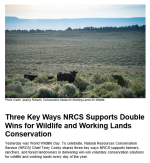Linda Poole
NCAT Regenerative Grazing Specialist
In honor of World Wildlife Day on March 3, NRCS released this article:


NRCS empowers voluntary, locally-led efforts that benefit wildlife, working lands, and agricultural communities.
Farmers, ranchers, and forest landowners are some of our nation’s most dedicated land stewards. At NRCS, we work with these producers to benefit wildlife while keeping working farms, ranches, and private forestlands healthy and productive. Our Working Lands for Wildlife (WLFW) effort unites conservation partners, producers, and other landowners through the shared vision of sustainable food and fiber production, healthy wildlife populations, and thriving local communities.
WLFW is driven by an innovative partnership between NRCS and the U.S. Fish and Wildlife Service (USFWS). Through WLFW:
Last summer, we announced a $500 million investment in WLFW over the next five years, with an additional $30 million to increase our science and coordination capacity through partnerships. Four new Frameworks for Conservation Action are in development for Western Migratory Big Game, Eastern Deciduous Forest, Eastern Aquatic Connectivity, and Southeastern Pine Ecosystems, and we’re updating three existing Frameworks to guide conservation efforts focused on the Sagebrush Biome, Great Plains Grasslands, and Northern Bobwhite, Grasslands, and Savannas. These updates will include integration of the Farm Service Agency’s Conservation Reserve Program. As a whole, these efforts will benefit wildlife, support agriculture and producers, and empower landscape-scale conservation through locally-led actions.
- NRCS supports landowners in implementing voluntary conservation practices that deliver targeted improvements for both key species and the working lands they inhabit. For example, brush management is a conservation practice used to reduce the threat of trees growing into and degrading grasslands. This benefits the operation through increased forage production for livestock, provides the conservation benefits of reduced wildfire and soil erosion risk, and improves wildlife habitat for grassland species.
- USFWS provides regulatory predictability under the Endangered Species Act. This gives producers the peace of mind that, no matter the legal status of species occurring on participating working lands, they can stay in production with an NRCS conservation plan in place.




